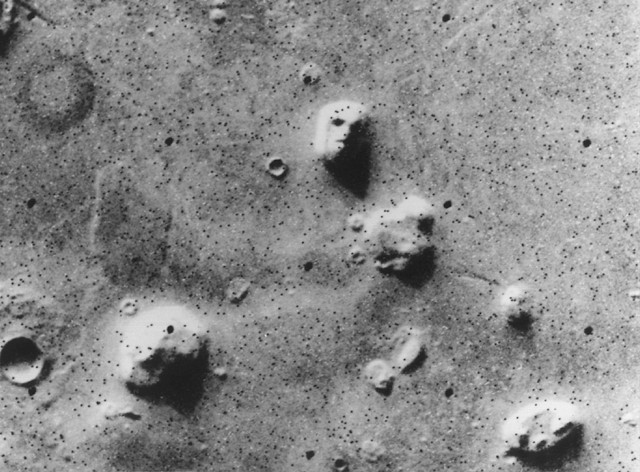 The Viking spacecraft reached Mars in July of 1976. It had two missions. One was to send a lander down to inspect the surface of Mars. The other was to orbit the red planet, within a 1,000 miles of the surface, and take thousands of pictures to help to determine the best landing site for the Viking 2 spacecraft due to reach Mars in a few weeks.
The Viking spacecraft reached Mars in July of 1976. It had two missions. One was to send a lander down to inspect the surface of Mars. The other was to orbit the red planet, within a 1,000 miles of the surface, and take thousands of pictures to help to determine the best landing site for the Viking 2 spacecraft due to reach Mars in a few weeks.On July 26, 1976, during Viking 1's thirty-fifth orbit of Mars, a set of photographic images arived at the Jet Propulsion Laboratory in Pasadena, California. One of the photographic frames, taken in the northern desert Cydonia region, showed a mile long, 1,500 mesa that looked like a humanoid face.
 Cydonia Mensae is an albedo feature (region) on Mars.
Cydonia Mensae is an albedo feature (region) on Mars. The Cydonia Region taken by the Viking 1 orbiter and released by NASA/JPL on July 25, 1976 (north is to the upper right).
The Cydonia Region taken by the Viking 1 orbiter and released by NASA/JPL on July 25, 1976 (north is to the upper right).Some commentators, most notably Richard C. Hoagland, believe it to be evidence of a long lost Martian civilization along with other features they believe are present, such as apparent pyramids, which they argue are part of a ruined city. Image analysis of the early Viking images led a few researchers to suggest that the features of the Face might not be an accidental consequence of viewing conditions.

No comments:
Post a Comment